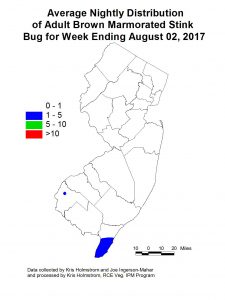Sweet Corn
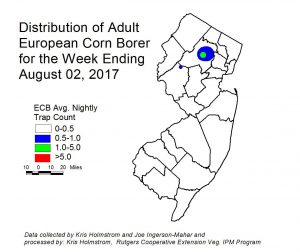 European corn borer (ECB) catches remain low, but are occurring in some locations with greater intensity (see ECB map at left). This is the early part of the second flight. In recent years, this flight has been very sporadic. ECB feeding in NJ sweet corn plantings is still nearly non-existent at this time, but should appear again within a week, although it may be obscured by fall armyworm (FAW) feeding. Check 5 plants each in 10 random locations for a 50 plant sample. Look for “shot-hole” injury, and consider treating when the number of infested (from ECB or FAW) plants in a 50 plant sample exceeds 12%. As infested plants proceed to the pre-tassel stage, live larvae and damage may be found in the emerging tassels. Once plants hit full tassel, ECB larvae will move downward on the stalk and re-enter the plant near the area where ears are forming. This can result in direct injury to the ear. Growers should consider an insecticide application at the full tassel stage to target ECB larvae as they migrate downward. This application can eliminate larvae that have escaped any earlier insecticide applications.
European corn borer (ECB) catches remain low, but are occurring in some locations with greater intensity (see ECB map at left). This is the early part of the second flight. In recent years, this flight has been very sporadic. ECB feeding in NJ sweet corn plantings is still nearly non-existent at this time, but should appear again within a week, although it may be obscured by fall armyworm (FAW) feeding. Check 5 plants each in 10 random locations for a 50 plant sample. Look for “shot-hole” injury, and consider treating when the number of infested (from ECB or FAW) plants in a 50 plant sample exceeds 12%. As infested plants proceed to the pre-tassel stage, live larvae and damage may be found in the emerging tassels. Once plants hit full tassel, ECB larvae will move downward on the stalk and re-enter the plant near the area where ears are forming. This can result in direct injury to the ear. Growers should consider an insecticide application at the full tassel stage to target ECB larvae as they migrate downward. This application can eliminate larvae that have escaped any earlier insecticide applications.
The highest nightly ECB catches for the previous week are as follows:
| Denville 2 | Elm 1 | Medford 1 |
| Allentown 1 | Hillsborough 1 | Pedricktown 1 |
| Califon 1 | Jobstown 1 | Pennington 1 |
| East Vineland 1 | Lawrenceville 1 | Sparta 1 |
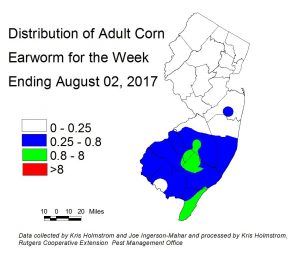 Corn earworm (CEW) moth catches have intensified somewhat in the southern half of the state, while declining in the north (see CEW map at left). Virginia Extension is reporting reasonably high CEW catches in coastal areas now, while catches in North Carolina are declining. Delaware’s pheromone traps are recording some increases. CEW moth emergence is progressing northward at this time, and we might expect to see more consistent state-wide catches within a week. The major migratory influx of moths generally does not occur until after mid-August in NJ, but we have seen this happen as early as the first week of August.
Corn earworm (CEW) moth catches have intensified somewhat in the southern half of the state, while declining in the north (see CEW map at left). Virginia Extension is reporting reasonably high CEW catches in coastal areas now, while catches in North Carolina are declining. Delaware’s pheromone traps are recording some increases. CEW moth emergence is progressing northward at this time, and we might expect to see more consistent state-wide catches within a week. The major migratory influx of moths generally does not occur until after mid-August in NJ, but we have seen this happen as early as the first week of August.
The highest nightly CEW blacklight trap catches are as follows:
| Green Creek 4 | East Vineland 1 | Medford 1 |
| Folsom 2 | Eldora 1 | Pedricktown 1 |
| Tabernacle 2 | Elm 1 | Springdale 1 |
| Downer 1 | Farmingdale 1 | Woodstown 1 |
Southern NJ CEW pheromone trap catches increased this past week, in a manner consistent with blacklight catches. This more conservative network is also indicating an increased threat level (see CEW pheromone map below at right). There are relatively few pheromone traps deployed compared to the number of blacklight traps in the state, resulting in much broader color bands on the pheromone map.
At present, the highest nightly pheromone trap catches are as follows: 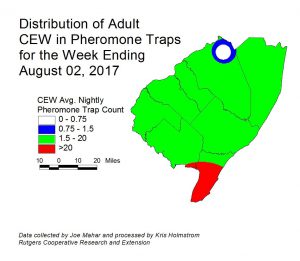
| Green Creek 52 | Berlin 4 |
| Pedricktown 18 | East Vineland 4 |
| Beckett 16 | Elm 4 |
| Woodstown 8 | |
| Pole Tavern 6 |
Fall Armyworm
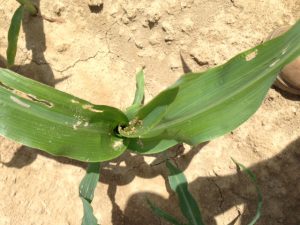 Fall armyworm (FAW) infestations in NJ have tapered off recently. While new damage is being found on whorl stage plants, the occurrence has been lower than expected for this time of year, particularly since we have had some level of infestation for a month. Larval populations are being managed effectively with appropriate insecticides when the infestations are identified promptly. We should be alert for increased infestation in the near future. This pest favors smaller whorl stage plants, and will even infest seedling stage plants if
Fall armyworm (FAW) infestations in NJ have tapered off recently. While new damage is being found on whorl stage plants, the occurrence has been lower than expected for this time of year, particularly since we have had some level of infestation for a month. Larval populations are being managed effectively with appropriate insecticides when the infestations are identified promptly. We should be alert for increased infestation in the near future. This pest favors smaller whorl stage plants, and will even infest seedling stage plants if the population is high. This pest is capable of serious injury to plants, and scouting should commence immediately on whorl corn throughout the southern half of the state. Look for plants with “window-pane” type feeding that leads from the outer leaf surface down into the whorl (see photo at left). As larvae grow, this damage will progress to obvious ragged holes, with lots of caterpillar droppings in the whorl. The larvae are tan and brown (see photo at right), with a conspicuous upside down “Y” on the head capsule. If FAW alone or in combination with ECB are found to infest 12% or more plants in the sample, consider an insecticide treatment. FAW do not respond well to synthetic pyrethroid insecticides. In general, IRAC Group 5 materials like Radiant or Entrust (OMRI approved) or IRAC Group 28 materials like Coragen (or those that contain Coragen as a component) work very well on FAW and other caterpillar pests.
the population is high. This pest is capable of serious injury to plants, and scouting should commence immediately on whorl corn throughout the southern half of the state. Look for plants with “window-pane” type feeding that leads from the outer leaf surface down into the whorl (see photo at left). As larvae grow, this damage will progress to obvious ragged holes, with lots of caterpillar droppings in the whorl. The larvae are tan and brown (see photo at right), with a conspicuous upside down “Y” on the head capsule. If FAW alone or in combination with ECB are found to infest 12% or more plants in the sample, consider an insecticide treatment. FAW do not respond well to synthetic pyrethroid insecticides. In general, IRAC Group 5 materials like Radiant or Entrust (OMRI approved) or IRAC Group 28 materials like Coragen (or those that contain Coragen as a component) work very well on FAW and other caterpillar pests.
Silking Spray Schedules*:
South – 3-4 days
Central – 5-6 days
North – 6-7 days
*These recommendations are based on regional catches. Adhere to tighter spray schedules if indicated by local trap catches.
Pepper Weevil Update
No weevils have been caught in the past week. August is the month when most of the pepper weevil infestations have been found in New Jersey. Once we get past August, the threat of pepper weevil rapidly diminishes. As far as known, there are no infested fields at this time.
Blacklight trap catches of the brown marmorated stink bug (BMSB) decreased in NJ this past week (see BMSB map at left). Many of our brown stinkbugs and BMSB are now in the adult stage and seeking hosts on which to feed and lay eggs. Scouts are reporting increased sightings of native stinkbugs in tomatoes and peppers. Scouting for stinkbugs in these crops requires stealth, as the bugs will retreat into the canopy if they perceive a threat. While scouting for other insects and diseases, approach each sample site slowly. Before disturbing the foliage to search for ECB eggs, aphids, etc., observe the upper canopy for the presence of stinkbugs. Often, they will bask on the upper leaves. If adults, nymphs or egg masses are found in 2 or more sites in a pepper planting, consider treating preventively to limit feeding injury to fruit. There are several insecticide options listed in the 2016-17 Commercial Vegetable Production Recommendations.
Pumpkins and Winter Squash
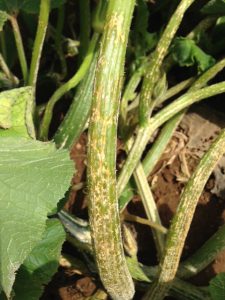 Recently, a pumpkin field in Morris County developed a significant Plectosporium infection. This fungal disease causes small, dry, whitish spots to form on the petioles (see photo at left). Petioles may become brittle and snap as a result. If not managed effectively, these same small dry spots will develop on the surface of fruit, making them unmarketable. The disease is favored by excessively wet weather. In this case, the affected portion of the field was where water drained from a hillside, and the soil remained wet for some time. The fungicides recommended for powdery mildew are also effective at managing Plectosporium blight
Recently, a pumpkin field in Morris County developed a significant Plectosporium infection. This fungal disease causes small, dry, whitish spots to form on the petioles (see photo at left). Petioles may become brittle and snap as a result. If not managed effectively, these same small dry spots will develop on the surface of fruit, making them unmarketable. The disease is favored by excessively wet weather. In this case, the affected portion of the field was where water drained from a hillside, and the soil remained wet for some time. The fungicides recommended for powdery mildew are also effective at managing Plectosporium blight
Cucurbit downy mildew (CDM) remains active on cucumber in NJ. Examination of the sentinel 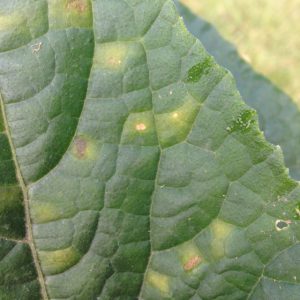 plot (see previous posts for explanation of these plots) at the Snyder Research and Extension Farm in Hunterdon County showed that the cucumber varieties ‘Straight 8’ and ‘sv3462’ are now infected. No other cucurbit crops in the plot were infected. The sentinel plots at Snyder Farm and RAREC are just two of a network of sentinel plots in the eastern half of North America that will contribute information to the CDM forecast (http://cdm.ipmpipe.org/). These plots are scouted weekly for the presence of CDM. If found, the disease is reported to NC State Univ., the organization managing the forecast. Affected crops are also identified. The purpose of this is to provide early warning to growers of these crops so that they may react proactively to the disease, and treat the appropriate crops. A this time, it is important for all cucurbit growers to check the above website at least weekly for updates on the movements of CDM in the eastern U.S. While the imminent threat appears to be confined to cucumber, infections on other crops such as musk melon and butternut squash have been reported in western PA. As of 8/01/17, the CDM forecast issued by NC State had NJ at low risk to develop new infections from regional sources. Existing infections will continue to develop. ALL cucurbit crops should be scouted for the presence of CDM, and all cucumber plantings should be treated preventively. CDM causes yellow lesions to develop on the upper leaf surface (see photo above at right). Lesions are confined within veins initially, but coalesce quickly to kill the entire leaf when moist conditions prevail. Beneath these lesions (lower leaf surface), dark gray spores will be produced (see lower photo at right). If discovered, please report any incidence of CDM to your county agent as soon as possible.
plot (see previous posts for explanation of these plots) at the Snyder Research and Extension Farm in Hunterdon County showed that the cucumber varieties ‘Straight 8’ and ‘sv3462’ are now infected. No other cucurbit crops in the plot were infected. The sentinel plots at Snyder Farm and RAREC are just two of a network of sentinel plots in the eastern half of North America that will contribute information to the CDM forecast (http://cdm.ipmpipe.org/). These plots are scouted weekly for the presence of CDM. If found, the disease is reported to NC State Univ., the organization managing the forecast. Affected crops are also identified. The purpose of this is to provide early warning to growers of these crops so that they may react proactively to the disease, and treat the appropriate crops. A this time, it is important for all cucurbit growers to check the above website at least weekly for updates on the movements of CDM in the eastern U.S. While the imminent threat appears to be confined to cucumber, infections on other crops such as musk melon and butternut squash have been reported in western PA. As of 8/01/17, the CDM forecast issued by NC State had NJ at low risk to develop new infections from regional sources. Existing infections will continue to develop. ALL cucurbit crops should be scouted for the presence of CDM, and all cucumber plantings should be treated preventively. CDM causes yellow lesions to develop on the upper leaf surface (see photo above at right). Lesions are confined within veins initially, but coalesce quickly to kill the entire leaf when moist conditions prevail. Beneath these lesions (lower leaf surface), dark gray spores will be produced (see lower photo at right). If discovered, please report any incidence of CDM to your county agent as soon as possible.
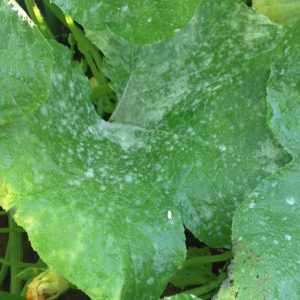 Powdery mildew (PM) infections are now on most pumpkin and winter squash fields. The appearance of PM is not related to weather, but rather the maturity and stress level of plants. This disease is not nearly as destructive as DM, but must be managed sufficiently to permit continued vine health. PM lesions first appear as circular clusters of conidia (spores) on the upper or lower surface of older leaves (see photo at left). PM typically appears as the earliest fruit are developing. The threshold for beginning the PM protectant fungicide program is the appearance of 2 leaves with lesions out of a sample of 100 older leaves. For a comprehensive list of useful fungicides and their use in rotation, see the Pumpkin and Winter Squash section of the 2016-17 Commercial Vegetable Recommendations Guide.
Powdery mildew (PM) infections are now on most pumpkin and winter squash fields. The appearance of PM is not related to weather, but rather the maturity and stress level of plants. This disease is not nearly as destructive as DM, but must be managed sufficiently to permit continued vine health. PM lesions first appear as circular clusters of conidia (spores) on the upper or lower surface of older leaves (see photo at left). PM typically appears as the earliest fruit are developing. The threshold for beginning the PM protectant fungicide program is the appearance of 2 leaves with lesions out of a sample of 100 older leaves. For a comprehensive list of useful fungicides and their use in rotation, see the Pumpkin and Winter Squash section of the 2016-17 Commercial Vegetable Recommendations Guide.
